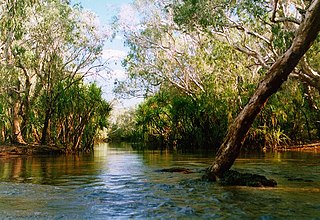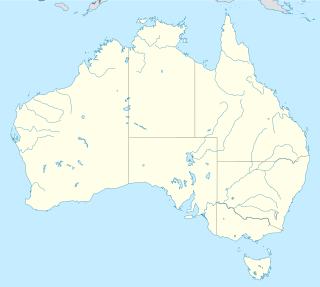
The Australian Aboriginal languages consist of around 290–363 languages belonging to an estimated 28 language families and isolates, spoken by Aboriginal Australians of mainland Australia and a few nearby islands. The relationships between these languages are not clear at present. Despite this uncertainty, the Indigenous Australian languages are collectively covered by the technical term "Australian languages", or the "Australian family".
Maningrida is an Aboriginal community in the heart of the Arnhem Land region of Australia's Northern Territory. Maningrida is 500 km (311 mi) east of Darwin, and 300 km (186 mi) north east of Jabiru. At the 2016 census, Maningrida had a population of 2,308.
In linguistics, fortis and lenis, sometimes identified with tense and lax, are pronunciations of consonants with relatively greater and lesser energy. English has fortis consonants, such as the p in pat, with a corresponding lenis consonant, such as the b in bat. Fortis and lenis consonants may be distinguished by tenseness or other characteristics, such as voicing, aspiration, glottalization, velarization, length, and length of nearby vowels. Fortis and lenis were coined for languages where the contrast between sounds such as p and b does not involve voicing.
Ngalakan (Ngalakgan) is an Australian Aboriginal language of the Ngalakgan people. It has not been fully acquired by children since the 1930s. It is one of the Northern Non-Pama–Nyungan languages formerly spoken in the Roper river region of the Northern Territory. It is most closely related to Rembarrnga.
Although Australia has no official languages, English has been entrenched as the de facto national language since European settlement. Australian English is a major variety of the language with a distinctive accent and lexicon, and differs slightly from other varieties of English in grammar and spelling. General Australian serves as the standard dialect.
Nicholas Evans is an Australian linguist and a leading expert on endangered languages.

The northern or sandy nail-tail wallaby refers to Onychogalea unguifera, a species of macropod found across northern Australia on arid and sparsely wooded plains. The largest species of the genus Onychogalea, it is a solitary and nocturnal herbivorous browser that selects its food from a wide variety of grasses and succulent plant material. Distinguished by a slender and long-limbed form that resembles the typical and well known kangaroos, although their standing height is shorter, around half of one metre, and their weight is less than nine kilograms. As with some medium to large kangaroo species, such as Macropus rufus, they have an unusual pentapedal motion at slow speeds by stiffening the tail for a fifth limb. When fleeing a disturbance, they hop rapidly with the tail curled back and repeatedly utter the sound "wuluhwuluh". Their exceptionally long tail has a broad fingernail-like protuberance beneath a dark crest of hair at its end, a peculiarity of the genus that is much broader than the other species. The name unguifera, meaning claw, is a reference to this extraordinary attribute, the purpose of which is unknown.

Emeritus Professor Kenneth James (Ken) Maddock was an eminent anthropologist in Australia, and respected, rigorous scholar of Australian Aboriginal societies.
Gunbarlang (Kunbarlang) is an Australian Aboriginal language in northern Australia with multiple dialects. Other names are Gungalang and Warlang. Speakers are multilingual in Kunwinjku and Mawng. Most of the Gunbarlang people now speak Kunwinjku.
Rembarrnga (Rembarunga) is an Australian Aboriginal language. It is one of the Northern Non-Pama–Nyungan languages, spoken in the Roper River region of the Northern territory. There are three dialects of Rembarrnga, namely Galduyh, Gikkik and Mappurn. It is a highly endangered language, with very few remaining fluent speakers. It is very likely that the language is no longer being learned by children. Instead, the children of Rembarrnga speakers are now learning neighbouring languages such as Kriol in south central Arnhem Land, and Kunwinjku, a dialect of Bininj Gunwok, in north central Arnhem Land.

The Macro-Gunwinyguan languages, also called Arnhem or Gunwinyguan, are a family of Australian Aboriginal languages spoken across eastern Arnhem Land in northern Australia. Their relationship has been demonstrated through shared morphology in their verbal inflections.
Janet Fletcher is an Australian linguist. She completed her BA at the University of Queensland in 1981 and then moved to the United Kingdom and received her PhD from the University of Reading in 1989.

The Living Archive of Aboriginal Languages is a digital archive of endangered literature in over forty Australian Indigenous languages from the Northern Territory, Australia. The project to build the archive was initially funded in 2012 by the Australian Research Council and involved the collaboration of the Charles Darwin University as the lead institution, the Northern Territory Government and the Australian National University. Later partners include the Batchelor Institute of Indigenous Tertiary Education, the Northern Territory Library and the Northern Territory Catholic Education Office.

The Goyder River is a river in the Northern Territory, Australia.
The Ngalakgan are an indigenous Australian people of the Northern Territory.
The Yangman were an indigenous Australian people of the Northern Territory.
The Wilton River is a large perennial river, and tributary of the Roper River located in the Katherine region of the Northern Territory, Australia.
The Kenneth L. Hale Award, named after linguist Kenneth L. Hale, is an award given to a member of the Linguistic Society of America in order to recognize "scholars who have done outstanding work on the documentation of a particular language or family of languages that is endangered or no longer spoken." It has been described as one "response to the urgency of recording endangered languages before they disappear."






